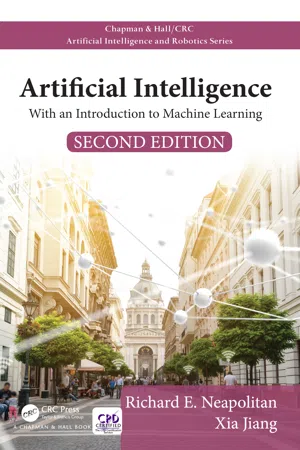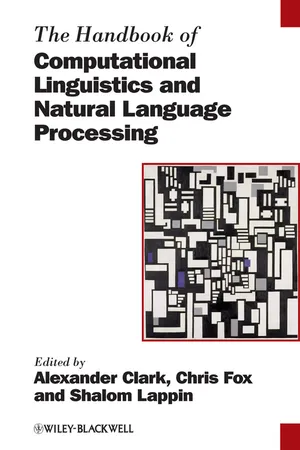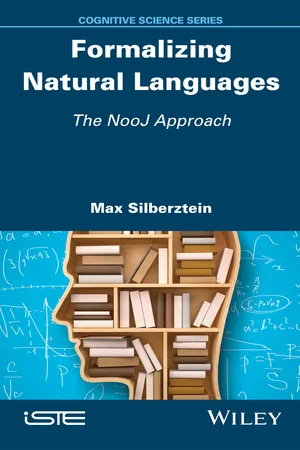Computer Science
Context Free Grammar
Context-free grammar is a formal grammar that describes a language by defining its syntax through a set of production rules. It is used in computer science to generate programming languages, compilers, and parsers. It is called "context-free" because the production rules apply regardless of the context in which a symbol appears.
Written by Perlego with AI-assistance
Related key terms
5 Key excerpts on "Context Free Grammar"
- eBook - ePub
Theory of Computation Simplified
Simulate Real-world Computing Machines and Problems with Strong Principles of Computation (English Edition)
- Dr. Varsha H. Patil, Dr. Vaishali S. Pawar, Dr. Swati A. Bhavsar, Dr. Aboli H. Patil(Authors)
- 2022(Publication Date)
- BPB Publications(Publisher)
(a + b)^d/e + (S – T)S → (a + b)^d/e + (T – V)S → (a + b)^d/e + (V – F)S → (a + b)^d/e + (F – I)S → (a + b)^d/e + (I – F)S → (a + b)^d/e + (– F),Hence, proved.Conclusion
In this chapter, we learnt the basic elements of grammar and it definition. The Context Free Grammar is a way of describing languages by using production rules. Derivations and languages are generated by using the start symbol and a string of terminals is derived by repeatedly replacing it by the body of production rules. While replacing, if we replace the leftmost non-terminal, then the resulting derivation is leftmost, else if we replace the rightmost non-terminal, then the resulting derivation is rightmost. We also learnt the concept of ambiguous grammar and how to remove ambiguity form it. Then we learnt the representation of grammar in two types of normal forms such as Chomsky normal form and Greibach normal form. Further, the types of grammar were studied using Chomsky hierarchy. At the end of the chapter, we learnt the applications of Context Free Grammar. - eBook - ePub
Automata and Computability
A Programmer's Perspective
- Ganesh Gopalakrishnan(Author)
- 2019(Publication Date)
- Chapman and Hall/CRC(Publisher)
7The basic goal of designing a CFG is to come up with an elegant set of rules that are intuitively correct, and (upon being challenged) rigorously shown to be consistent and complete. Many such proofs can be elegantly structured around a rather nice picture which we call the “hill/valley” plot.8Example: For our illustration, consider a different language, namely Leqab , which is exactly the set of all strings that contain an equal number of a ’s and b ’s. We can derive a CFG for it by growing the language inside-out.9 More specifically,• ε is in the language, and therefore we must include a production of the form S -> ″• Now, we set up the pattern aSbS , and think inductively in our minds; we also indicate the questions that naturally arise:– If S is consistent, then placing an equal amount of a ’s and b ’s keeps it consistent.– But do we settle for aSb or aSbS ? We choose the latter, as it does not force a b -ending.– Do we include bSaS ? We feel it is necessary, to avoid an a -only ending.– Do we throw in an SS case? While doing so won’t cause inconsistency, it may be unnecessary for completeness (see below).Let us assume we don’t need the SS case, and present the CFG designed thus far:S -> ’’ | aSbS | bSaSWe now prove that this CFG is consistent, and the SS production is not necessary (the CFG is complete with respect to Leqab - eBook - ePub
Artificial Intelligence
With an Introduction to Machine Learning, Second Edition
- Richard E. Neapolitan, Xia Jiang(Authors)
- 2018(Publication Date)
- Chapman and Hall/CRC(Publisher)
- A set of terminal symbols. These are the words in the language such as “block”, “on”, “speak”, and “operator”.
- A set of nonterminal symbols. These symbols represent linguistic concepts that categorize phrases in the language such as NounP hrase and V erbP hrase.
- A start symbol. This symbol represents the entire string being parsed. For the English language, it is S entence.
- A set of derivation rules. The nonterminal symbol on the left in these rules can be substituted by the terminal and nonterminal symbols on the right. For example, if we write “Noun → block,” then a Noun can be substituted by block.
- The “|” denotes “or”.
Such a grammar is a context-free grammar (CFG) , which means that there may only be one nonterminal symbol on the left in each rule. Table 16.1 shows a simple CFG grammar.Table 16.1 A CFGA grammar is in Chomsky normal form if every rule is of the form A B C or D word, where A , B , C , and D are nonterminals and “word” is a terminal. The context-free grammar in Table 16.1 is not in Chomsky normal form because of rules 2, 3, 6 and 10 through 15. It is possible to show that every context-free grammar can be transformed into a grammar that is in Chomsky normal form.The terminals are the words in the language, and the set of all of them is called the lexicon . The grammar in Table 16.1 shows a very small lexicon for illustration. Most grammars we would actually use would have a much larger lexicon. A legal sentence is a string of symbols that can be derived using a sequence of these rules. A derivation must start with the start symbol Sentence, perform a sequence of substitutions by applying the rules, and end up with the sentence being parsed.Example 16.1 Suppose we want to derive the following sentence:the monkey reads a book.The following is a derivation of this sentence using the grammar in Table 16.1 .■A derivation can be represented by a parse tree . Each non-leaf in the tree contains the nonterminal symbol on the left of a rule used in the derivation, and each of its children contains one of the terminal or nonterminal symbols on the right of the rule. Each leaf contains a terminal symbol. The root of the tree is the start symbol Sentence . Figure 16.2 - Alexander Clark, Chris Fox, Shalom Lappin(Authors)
- 2013(Publication Date)
- Wiley-Blackwell(Publisher)
n ). In fact, we have the following result concerning recognition complexity for context-sensitive languages.THEOREM 20. The universal recognition problem for CSGs is PSPACE-complete. Indeed, there exists a CSG G such that L (G )is PSPACE-complete.For a formal definition of context-sensitive grammars and a proof of Theorem 20, see Hopcroft and Ullman (1979b: 223 and 347ff.). It was long conjectured that the complement of a context-sensitive language is itself a context-sensitive language. This conjecture was settled, positively, by Theorem 4, using the fact that the context-sensitive languages coincide with NSPACE(n ).All the grammar frameworks examined so far have precise formal definitions, which makes for a clear-cut complexity analysis. However, many mainstream grammar frameworks which aspire to describe natural languages are much less rigidly defined (and indeed much more liable to periodic revision); consequently, it is harder to provide definitive results about computational complexity. Transformational grammar is a case in point. Let us take a transformational grammar to consist of two components: a CFG generating a collection of phrase-structure trees – so-called deep structures – and a collection of transformations which map these deep structures to other phrase-structure trees – so-called surface structures. A string σ is accepted by G just in case σ can be read off the leaves of some surface structure obtained in this way. Absent a formal specification of the sorts of transformations allowed in transformational grammar, it is impossible to determine the complexity of its recognition problem. However, analyzing a version of Chomsky’s aspects theory, Peters and Ritchie (1973) show the existence of transformational grammars which can recognize undecidable languages. Certainly, then, the universal recognition problem for transformational grammars (thus understood) is undecidable. Other analyses of grammar frameworks in the transformational tradition paint a picture of lower complexity, however. Thus, Berwick and Weinberg (1984: 125ff.) analyze the complexity of government-binding grammars,- eBook - ePub
Formalizing Natural Languages
The NooJ Approach
- Max Silberztein(Author)
- 2016(Publication Date)
- Wiley-ISTE(Publisher)
context-sensitive languages.- – Type 0: unrestricted grammars contain rules without any restriction; that is, with any combination of auxiliary and terminal symbols in each of their two sides. Unrestricted grammars can describe any recursively enumerable language8 .
The set of all regular languages is included in the set of all context-free languages; the set of all context-free languages is included in the set of all context-sensitive languages; and the set of all context-sensitive languages is included in the set of all recursively enumerable languages.Likewise, all regular grammars are context-free grammars, all context-free grammars are context-sensitive grammars, and all context-sensitive grammars are unrestricted grammars9 .Figure 5.3.Chomsky-Schutzenberger hierarchyWith each type of generative grammar, we associate a type of machine capable of automatically applying this grammar to verify whether a given sentence belongs to the language described by the grammar, as well as produce at will any sentence of the language described by the grammar. This gives us the following four correspondences:
Learn about this page
Index pages curate the most relevant extracts from our library of academic textbooks. They’ve been created using an in-house natural language model (NLM), each adding context and meaning to key research topics.




